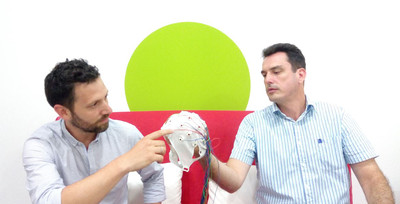A few days ago, I found a very curious news: Our brains are 'synchronised' during a conversation. And today I would like to share this news with you.

Something as simple as an everyday conversation causes the brains of two people to start working simultaneously. This is a study, conducted by the Basque Center on Cognition, Brain and Language (BCBL), published in the journal Scientific Reports.
Until now, the most traditional researches had hypothesised that brain 'synchronises', in function of what it is listening, adjusting its rhythms to the auditory stimuli.
Now, experts from the center of San Sebastian have gone a step further and have simultaneously analysed the complex neural activity of two unknown people, who engage in dialogue for the first time.
The team, led by Alejandro Pérez, Manuel Carreiras and Jon Andoni Duñabeitia, has verified, by recording the brain electrical function, that the neuronal activity of two individuals, involved in a communicative act, is 'synchronised' to give way to a 'connection' among both subjects.

Alejandro Pérez, on the right side

Manuel Carreiras

Jon Adoni Duñabeitia
"It is an intercerebral communion, that goes beyond the language itself and can be a key factor in interpersonal relationships and understanding of language", explains Jon Andoni Duñabeitia.
In this way, the rhythm of the brain waves of the transmitter and receiver is adjusted to the physical properties of the sound of the verbally uttered message, in a conversation, thus generating a connection among the two brains, that begin to work together for the same purpose : the communication.
"The brains of two people come closer, thanks to language, and communication creates links among people, that go far beyond what can be perceived from the outside", the researcher at the Basque center adds. "We can tell if two people are talking to each other just by analysing their brain waves".
In order to carry out the study, the BCBL researchers placed 15 pairs of people of the same sex, who did not know each other, separated by a screen, thus ensuring that the connection generated was actually through established communication.
Following a script, the couples engaged in a general conversation and, in turns, the protagonists exchanged the role of spokesperson and receiver.
Through electroencephalography (EEG) --a non-invasive test, that analyses the electrical activity of brain--, scientists measured the movement of brain waves simultaneously and found that, the oscillations of the same, occurred at the same time.
"Being able to know if two people are talking to each other, and even what they are talking about, just by looking at their brain activity, is a wonderful thing. Now we can explore new applications of great utility, in special communicative contexts, like in the case of people with difficulties to communicate", Duñabeitia emphasises.
In the future, knowledge of this interaction among two brains would allow us to understand and analyse very complex aspects, in the field of Psychology, Sociology, Psychiatry or Education, using neuroimaging within a realistic or ecological context.
"Demonstrating the existence of a neuronal synchrony, between people talking, has been only a first step", Alejandro Perez says. "Many questions and challenges are away for us to solve".
The author of the BCBL argues that, in addition, the practical potential is enormous. "Communication problems occur every day, and what we plan to do is to strengthen that described intercerebral coupling, in order to improve communication", Pérez concludes.
For researchers, the next step will be to check, using the same technique and dynamic of pairs, if the brains of two people are 'synchronised', in the same way, when the conversation takes place in a non-native language.
Well, I hope that you have liked this news, such as I did.
Until my next post, kind regards,
Luis.
Sponsored by Costaluz Lawyers.
Please click below:
